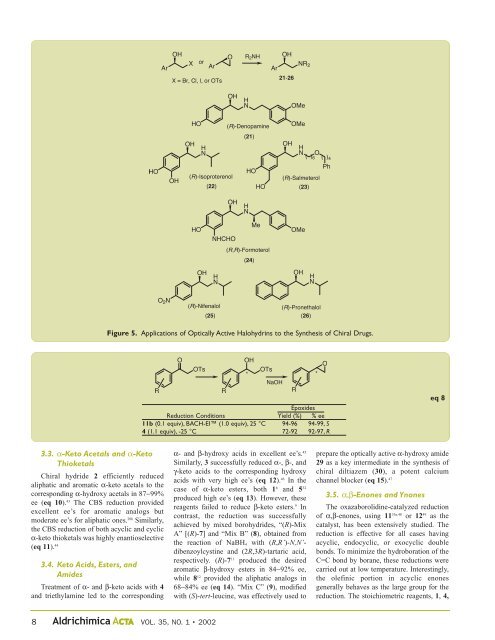DEDICATED TO PROFESSOR HC BROWN ON HIS ... - Sigma-Aldrich
DEDICATED TO PROFESSOR HC BROWN ON HIS ... - Sigma-Aldrich
DEDICATED TO PROFESSOR HC BROWN ON HIS ... - Sigma-Aldrich
Create successful ePaper yourself
Turn your PDF publications into a flip-book with our unique Google optimized e-Paper software.
3.3. α-Keto Acetals and α-Keto<br />
Thioketals<br />
Chiral hydride 2 efficiently reduced<br />
aliphatic and aromatic α-keto acetals to the<br />
corresponding α-hydroxy acetals in 87−99%<br />
ee (eq 10). 43 The CBS reduction provided<br />
excellent ee’s for aromatic analogs but<br />
moderate ee’s for aliphatic ones. 20b Similarly,<br />
the CBS reduction of both acyclic and cyclic<br />
α-keto thioketals was highly enantioselective<br />
(eq 11). 44<br />
3.4. Keto Acids, Esters, and<br />
Amides<br />
Treatment of α- and β-keto acids with 4<br />
and triethylamine led to the corresponding<br />
Figure 5. Applications of Optically Active Halohydrins to the Synthesis of Chiral Drugs.<br />
8 VOL. 35, NO. 1 • 2002<br />
Epoxides<br />
Reduction Conditions Yield (%) % ee<br />
11b (0.1 equiv), BACH-EI (1.0 equiv), 25 °C 94-96 94-99, S<br />
4 (1.1 equiv), -25 °C 72-92 92-97, R<br />
α- and β-hydroxy acids in excellent ee’s. 45<br />
Similarly, 3 successfully reduced α-, β-, and<br />
γ-keto acids to the corresponding hydroxy<br />
acids with very high ee’s (eq 12). 46 In the<br />
case of α-keto esters, both 1 6 and 5 32<br />
produced high ee’s (eq 13). However, these<br />
reagents failed to reduce β-keto esters. 9 In<br />
contrast, the reduction was successfully<br />
achieved by mixed borohydrides, “(R)-Mix<br />
A” [(R)-7] and “Mix B” (8), obtained from<br />
the reaction of NaBH4 with (R,R’)-N,N’dibenzoylcystine<br />
and (2R,3R)-tartaric acid,<br />
respectively. (R)-7 11 produced the desired<br />
aromatic β-hydroxy esters in 84−92% ee,<br />
while 8 12 provided the aliphatic analogs in<br />
68−84% ee (eq 14). “Mix C” (9), modified<br />
with (S)-tert-leucine, was effectively used to<br />
prepare the optically active α-hydroxy amide<br />
29 as a key intermediate in the synthesis of<br />
chiral diltiazem (30), a potent calcium<br />
channel blocker (eq 15). 47<br />
3.5. α,β-Enones and Ynones<br />
eq 8<br />
The oxazaborolidine-catalyzed reduction<br />
of α,β-enones, using 11 35a,48 or 12 49 as the<br />
catalyst, has been extensively studied. The<br />
reduction is effective for all cases having<br />
acyclic, endocyclic, or exocyclic double<br />
bonds. To minimize the hydroboration of the<br />
C=C bond by borane, these reductions were<br />
carried out at low temperature. Interestingly,<br />
the olefinic portion in acyclic enones<br />
generally behaves as the large group for the<br />
reduction. The stoichiometric reagents, 1, 4,

















